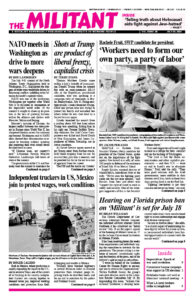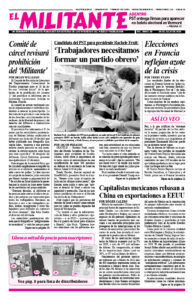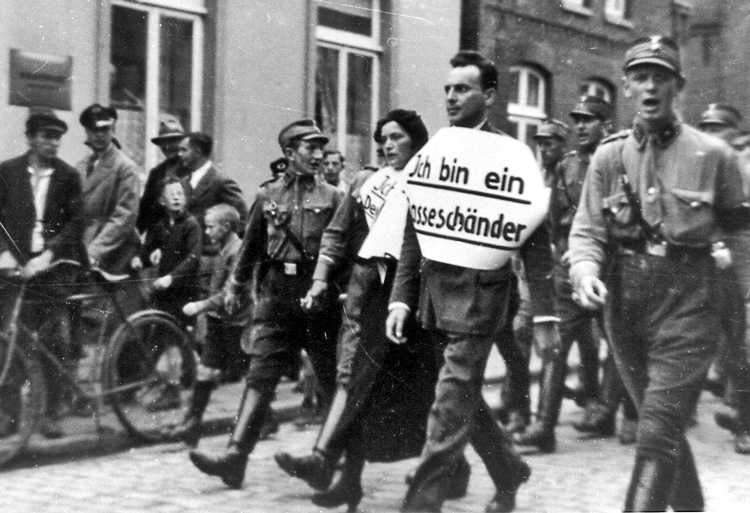NORDEN, Germany — A trip I made to Germany in early July brought home how alive the legacy of the Nazi Holocaust remains here, and its relevance given the rise of Jew-hatred worldwide, especially after Hamas’ Oct. 7 pogrom, which killed 1,200 Jews in Israel.
I had the opportunity to meet several people, both in this northeastern town of Norden and in Hamburg, who have devoted themselves to teaching new generations about the history of the Jewish people in Germany, and the lessons of the Nazi slaughter for the fight against Jew-hatred today.
Almut Holler is a retired Lutheran pastor in Norden and longtime leader of the Ecumenical Working Group for Synagogue Lane, which has worked tirelessly to rescue the legacy of the town’s Jewish population. Holler and schoolteacher Petra Drueke, co-director of the Working Group, gave a group of visitors a tour of Norden’s Synagogue Lane, where the town’s synagogue and other Jewish community buildings had been located.
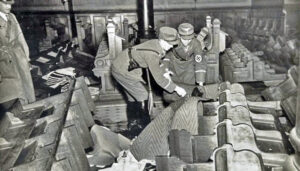
On Nov. 9, 1938, Nazi paramilitary thugs burned down the synagogue in Norden, along with 1,400 other Jewish temples across Germany. The violent rampage is known as Kristallnacht, the Night of the Broken Glass.
“In German public schools today, including the classes I teach, we call it Pogromnacht, Pogrom Night,” Drueke told us.
Jewish shops and homes were ransacked, Holler said. Jewish men were locked up in the local slaughterhouse and tortured with electric cattle prods, forced to reveal all their assets, which were confiscated. Some were taken to the Sachsenhausen concentration camp and brutalized there for weeks. Older Jewish men and women were forced to clear the still-smoking ruins of the synagogue. Nationwide, Jews were required to pay for all damages to their residences and businesses.
From the time Adolf Hitler became chancellor of Germany in January 1933, the Nazi regime dismissed accounts of escalating terror as “Jewish atrocity propaganda.” Today apologists for Hamas’ pogrom do the same, asserting that reports about Oct. 7 are “Zionist atrocity propaganda.”
Pogromnacht was an acceleration of the Nazi regime’s efforts to make Germany, and all the territory it conquered, Judenrein, cleansed of Jews. This led to the network of concentration camps and the systematic murder of 6 million Jews in Europe — 40% of the world’s Jewish population.
Scapegoating of Jews, then and now
In the years leading up to Pogromnacht, a Nazi-led boycott of Jewish shops drove many out of business. Jews were barred from civil service jobs and other professions. Jewish children were excluded from public schools. Jews were forced to wear a yellow star labeled “Jew.” In Nazi-occupied Netherlands, young Anne Frank wrote in her diary in 1942 that Jews were subjected to daily curfews, weren’t allowed to ride streetcars or own bicycles, or to go to parks, cinemas, libraries and sporting events.
In the educational center of the Ecumenical Working Group, housed in the former Jewish school, Holler and Drueke showed us books and photo displays they use to educate on the history of Norden’s Jewish community. One was a 1935 photo of Julius Wolff, who was Jewish, and his non-Jewish fiancée Christine Neemann being paraded through the town’s main street by Nazi thugs. Wolff was forced to carry a sign saying, “I am a race defiler.”
When I visited Hamburg, a volunteer historian took me to the notorious Holstenglacis jail, where my great-grandfather, Siegmund Meyer, was locked up in 1940. A 75-year-old widower, he was arbitrarily sentenced to five years in prison on charges of “race defilement” and died behind bars.
Holler and Drueke explained that the Nazis didn’t ask Jews whether they were religious before rounding them up — they were targeted as a people, an “inferior race.” In 1935 the Nazi government imposed the Nuremberg Race Laws, which stripped Jews of their German citizenship.
Today Hamas and its “Marxist” ally, the Popular Front for the Liberation of Palestine, deny Jews are a people. “They’re only a religion,” they say, asserting Israel has no right to exist as a nation and all the Jews should be driven out or killed.
Imperialist powers shut their doors
Norden, where part of my family was from, had a Jewish community for nearly 400 years. By 1940 it had been completely wiped out. Some emigrated before then, but half the community was murdered in Nazi concentration camps. Holler said by the late 1930s it had become nearly impossible for Jews to leave Germany, as the imperialist powers, and the Stalin-led Soviet regime, slammed their doors shut.
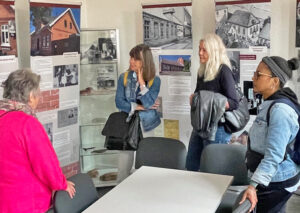
“At the Evian conference in 1938, all the big powers — Britain, the United States, all of them — refused to open their doors,” she said. The conference, called by the U.S. government to discuss the Jewish refugee crisis, met in France.
Holler noted how London sought to block Jewish immigration to British-controlled Palestine, as shown in its turning back the Exodus in 1947. Half of the ship’s refugees were forced into former German army barracks in Emden, 20 miles south of Norden.
She proudly added that Recha Freier, who was born in Norden, was one of many Jewish resistance fighters who risked their lives helping smuggle hundreds of Jews from Germany to Palestine during the war.
‘Never again is now’
Drueke and Holler told us the yearslong work of the Ecumenical Working Group to document the history of the former Jewish community and restore its historic sites is even more important today. In the window of the former Jewish school hangs a list of the names of Norden Jews murdered in the Holocaust. Above it is a sign in large letters that says “Nie wieder ist jetzt” — Never again is now.
They described the rise in anti-Jewish incidents in Germany today. We told them about growing attacks on Jews by supporters of Hamas in New York and elsewhere in the U.S.
When I visited Hamburg a couple of days later I met Andrea Althaus, who has been recording oral histories of German Jewish families. She told me of escalating threats against Jews by Hamas apologists in the city. Even academic seminars on the history of Jew-hatred now have to ask for police protection. “These antisemites are not interested in having a discussion,” she said. In response, there have been several actions in Hamburg protesting Jew-hatred.
“That’s why it’s important to tell the truth about the Holocaust and the fight against antisemitism,” Holler told us during our Norden visit. “The new generations need to know the real history and its relation to today.”
She pointed to the Nazi roots of Hamas. “Not many people know that the grand mufti of Jerusalem met with Hitler here in Germany in 1941” and they collaborated on joint efforts to exterminate Jews in Europe and the Mideast, Holler said. Amin al-Husseini, the mufti, organized pogroms against Jews in Palestine in the 1920s and ’30s, and after the war worked closely with the Egypt-based Muslim Brotherhood, which gave birth to Hamas.
To help highlight the legacy of the Holocaust, the Ecumenical Working Group has supported an international project to place small brass memorial plaques in front of former homes of victims of the Nazi terror. Some 100 have been laid in Norden, 7,000 in Hamburg and 100,000 across Europe.
Last November Drueke helped bring high school students to Norden’s former synagogue for an event “marking Pogromnacht and in solidarity with Israel.” The event, she said, condemned “Hamas’ brutal Oct. 7 attack, the biggest slaughter of Jews since the Holocaust.”
